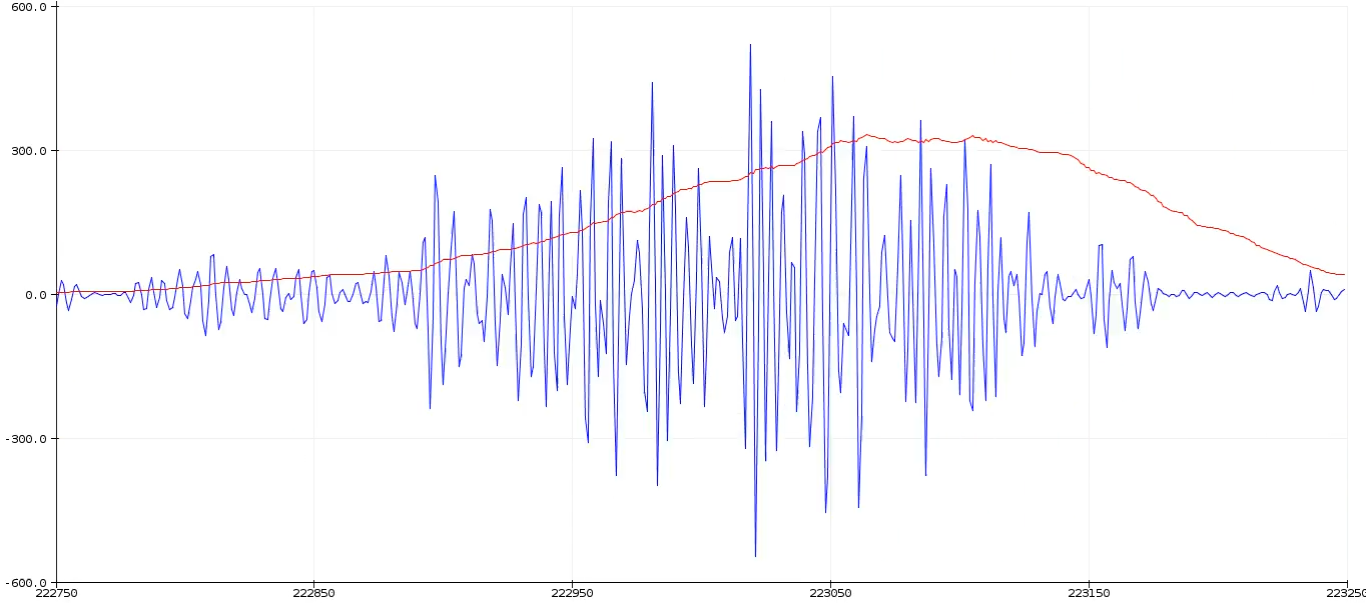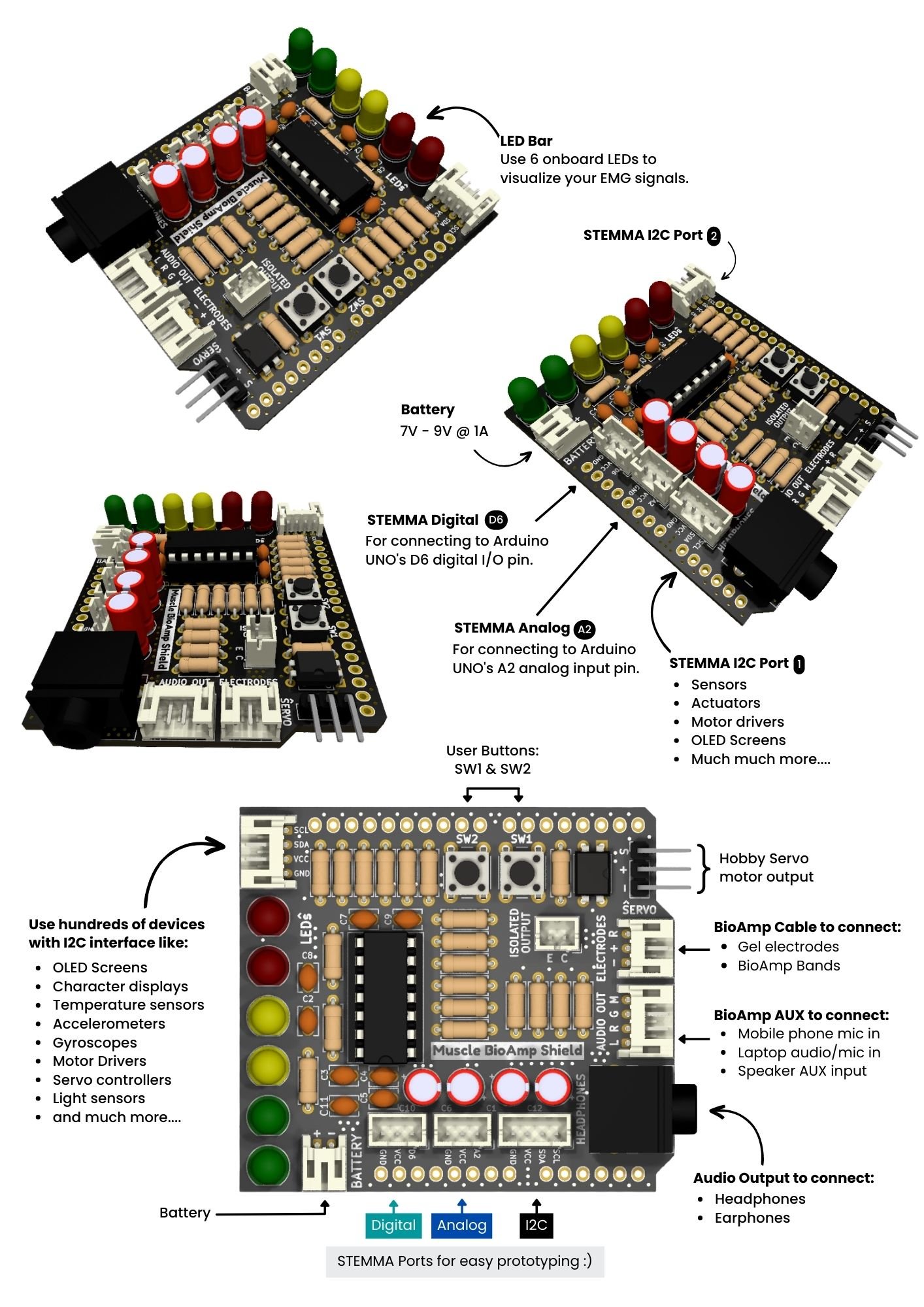Controlling Servo Claw With Muscle Signals Using Muscle BioAmp Shield
by Upside Down Labs in Circuits > Arduino
6413 Views, 50 Favorites, 0 Comments
Controlling Servo Claw With Muscle Signals Using Muscle BioAmp Shield

In this tutorial we are going to show you how to create a simple EMG system at your home so that you can record the muscle signals and control a servo claw using the Arduino Uno shield for EMG, Muscle BioAmp Shield. With this experiment you will learn the basics of how EMG controlled prosthetic hand works.
But before moving forward, let's understand a brief about Electromyography.
What is Electromyography (EMG)?
Electromyography is a technique that measures muscle response or electrical activity in response to a nerve’s stimulation of the muscle. We can use this electrical activity to detect neuromuscular abnormalities or create solutions for some crazy real-world problems like making artificial limb for amputees.

About Muscle BioAmp Shield:
Muscle BioAmp Shield is an all in one Arduino Uno Shield for Electromyography (EMG). It is perfect for beginners as it can be stacked on top of Arduino Uno to record, visualize and listen to the muscle signals to make amazing Human Computer Interface (HCI) projects. It also comes with various plug and play options so you can connect hundreds of devices like OLED screens, character displays, accelerometers, servo claw to name just a few using the I2C interface.
This is one of the product in the entire BioAmp series of sensors from Upside Down Labs which is designed in a way to teach you the basics of the instrumentation amplifier, active bandpass filtering, soldering, programming, neuroscience, Human Computer Interface (HCI), Brain Computer Interface (BCI), etc.

Supplies
HARDWARE:
1 x Muscle BioAmp Shield Kit (Upside Down Labs Store | Amazon India | Tindie Store)
- The Kit includes:
- Muscle BioAmp Shield PCB x 1
- Components
- Ceramic capacitors.
- Electrolytic capacitors
- Resistors
- Resistors
- LEDs
- Audio Jack
- Connectors
- Tactical Switch
- Optocoupler
- Quad OpAmp, etc.
- BioAmp Cable (100cm) x 1
- Gel Electrodes x 24
- Muscle BioAmp Band x 1
- BioAmp AUX Cable x 1
- 9V Snap Cable x 1
- STEMMA Cables x 6
1 x Arduino uno with USB cable (Type A to Type B)
1 x Servo Claw
Soldering iron and other equipments to solder the components on the PCB
SKIN PREPARATION KIT & ELECTRODE GEL:
1 x NuPrep skin preparation gel (Upside Down Labs Store | Tindie Store)
1 x Wet wipe
1 x Electrode Gel (only if using Muscle BioAmp Band) (Upside Down Labs Store | Tindie Store)
SOFTWARE:
Arduino IDE
Assembly

First of all, you have to assemble all the passive components on the Muscle BioAmp Shield PCB. For a step-by-step guide of the assembly, you can follow the video above or take a look at this interactive BOM.
Stacking on Arduino Uno

Stack the Muscle BioAmp Shield on top of Arduino Uno properly.
Skin Preparation

Apply Nuprep Skin Preparation Gel on the skin surface where electrodes would be placed to remove dead skin cells and clean the skin from dirt. After rubbing the skin surface thoroughly, clean it with a wet wipe.
About Nuprep Gel:
Nuprep skin preparation gel is a mildly abrasive, highly conductive gel that should be applied before placing the electrodes on the skin to improve measurements. When applied gently, it strips away the top layer of skin and moistens the underlying skin layer which reduces the skin impedance with minimal skin irritation and discomfort.
Connecting Electrode Cable

Connect the BioAmp Cable to Muscle BioAmp Shield as shown in the connection diagram.
Note: Don't place the electrodes on the skin at this moment.
Electrode Placements


We have 2 options to measure the EMG signals, either using the gel electrodes or using dry electrode based EMG band. You can try both of them one by one.
Measuring EMG using Gel electrodes:
- Connect the BioAmp Cable to gel electrodes,
- Peel the plastic backing from electrodes
- Place the IN+ and IN- cables on the arm near the ulnar nerve & REF (reference) at the back of your hand.
Measuring EMG using Muscle BioAmp Band, a dry electrode based EMG band:
- Connect the BioAmp Cable to Muscle BioAmp Band in a way such that IN+ and IN- are placed on the arm near the ulnar nerve & REF (reference) on the far side of the band.
- Now put a small drop of electrode gel between the skin and metallic part of BioAmp Cable to get the best results.
Connect Servo Claw

Connect the servo claw to Muscle BioAmp Shield as shown in the video above.
Download Arduino IDE
Download the Arduino IDE from the link given below:
https://www.arduino.cc/en/software
(We have used Arduino IDE version 1.8.19 for this project)
After downloading, connect the Arduino Uno to your laptop using the USB Cable (Type A to Type B)
Note: Make sure your laptop is not connected to a charger and sit 5m away from any AC appliances for best signal acquisition.
Coding Time!
Copy paste the Arduino Sketch given below in Arduino IDE:
Claw Controller: https://github.com/upsidedownlabs/Muscle-BioAmp-Arduino-Firmware/tree/main/04_Claw_Controller
Control Servo Claw by Flexing Your Muscles

Now flex your arm to control the servo claw in real time.
This is the same mechanism/working of how EMG controlled prosthetics work.
Let us know your feedback in the comments and feel free to ask any questions.
You can also mail us at support@upsidedownlabs.tech for any kind of support while you are making this project.
Some Other Projects

You can also make various other projects using Muscle BioAmp Shield like:
- Recording, visualizing and listenting to muscle signals (EMG): https://www.instructables.com/Record-Visualize-Listen-to-Muscle-Signals-Using-Mu/